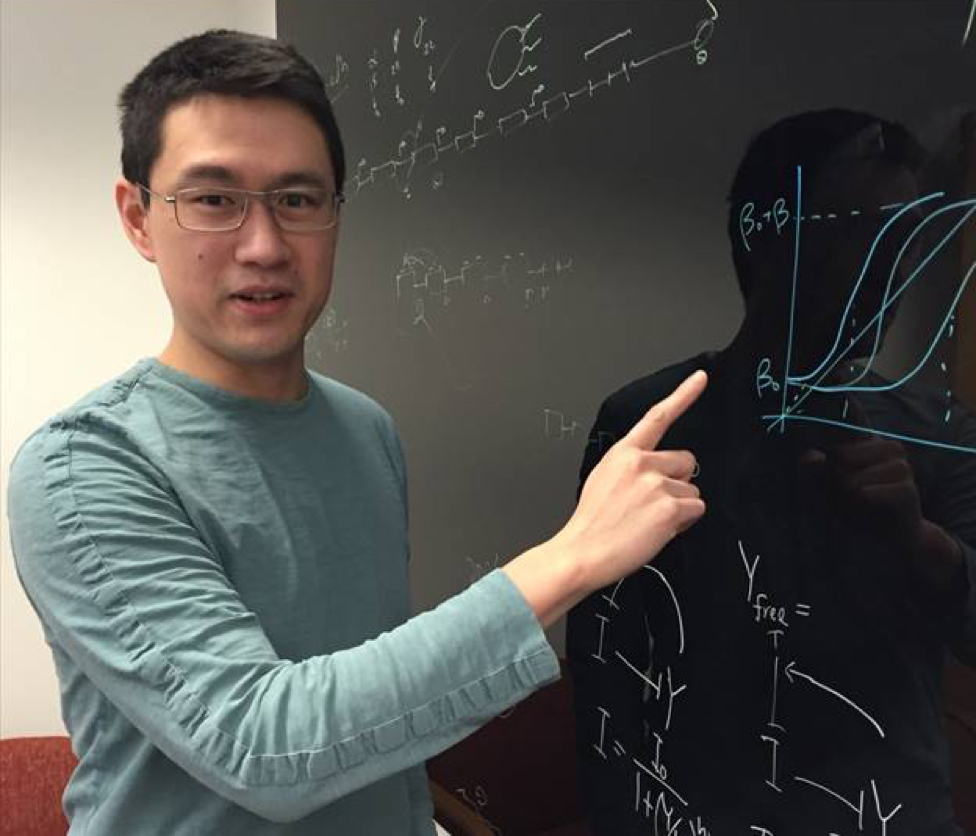
May 4, 2016
Gene-Wei Li is the newest member of the MIT Department of Biology. He opened his lab on the second floor in building 68 about one year ago. But who is Gene? Born in California and raised in Taiwan, Gene fell in love with math and physics and a boyhood dream to figure out quantum teleportation. It was not until he arrived at Harvard that he discovered the field of biophysics. “As a physicist I like thinking about numbers and when I came to Harvard I suddenly realized there was so much biophysics going on in a diversity of labs,” Gene says of his years in graduate school.
In his thesis project, Gene was looking at how transcription factors find their target through single molecule imaging in bacterial cells. He became focused on protein dynamics. Do transcription factors diffuse through cytosol and randomly land on DNA or do they scan through in a directional manner? He discovered they do a bit of both. “As a cell you would optimize the amount of transcription factors searching at any given time and the number of sites. You would not want to crowd the DNA,” Gene explains smiling.
Despite his work in a biological system, Gene admits he still saw himself primarily as a physicist at the beginning of his postdoc. “When I started my postdoc at the Weissman lab at UCSF, I did not even know what ubiquitin was,” he laughs. That was soon to change. At UCSF, Gene utilized a novel method called ribosome profiling which enables the study of protein synthesis rates by looking at ribosome density. “In my postdoc, I was lucky to get a paper published early on and so I had an opportunity to explore what I enjoyed. Quantification is always hard so I decided to see whether there is a good metric to measure, and found a striking result that density corresponds to stoichiometry really well. All the subunits are made in proportion to their stoichiometry. While this makes intuitive sense it was not necessarily obvious before,” Gene describes his postdoctoral experience. What about single subunit proteins? “No protein acts alone,” Gene replies, “we need to look at a whole system — enzymes could be diffusing but receive substrates and the amount of enzyme matters. Make enough but not too much because that would be wasteful.”
Are there physical and quantitative principles behind the precise control of transcription and translation? How do cells fine-tune their RNA and protein production to result in correct stoichiometric complexes? And importantly, if a cell is engineered in the lab to express exogenous proteins are there detrimental effects? Gene’s growing team at MIT (currently, two graduate students, a technician, an undergraduate, and a joint postdoc) are focused on cracking precisely these key questions. “As a mentor, my philosophy is to be supportive but leave freedom for students and postdocs to explore on their own too. In graduate school, I was stuck on a project for two years but was also allowed to follow side stories that both eventually went to fruition.”
Gene’s lab uses bacteria (E.coli and B. subtilis) in their experimental work. “Their operons are surprisingly conserved despite a billion years’ separation. The power is in comparison though – even though the gene order and protein stoichiometry are conserved, these bugs use different tricks of post-transcriptional controls to get the same amount of proteins,” Gene says of his model organisms. Being a young faculty in the MIT Department of Biology is a very humbling experience because it has so much history, he adds. “Boris Magasanik from this department was one of the pioneers of bacterial physiology — we know the system much better now, we can quantitate it better too but he laid the foundation. My lab space is formerly Alexander Rich’s who discovered polysomes — now we are stretching polysomes individually and looking at the actual distribution of ribosomes along the mRNA.”
In his free time, Gene enjoys traveling with his wife though it has become more difficult with the recent birth of their son (congratulations!) and his three-year old brother. He loves meeting people of different backgrounds and thinking about science from different perspectives. “It takes a while to adjust from postdoc to faculty – becoming a manager, accountant, grant writer, colleague, mentor – leaving less time for research,” he says. “The nice thing about the MIT Biology Department is that I can knock on any door and ask for advice on things big and small.”
